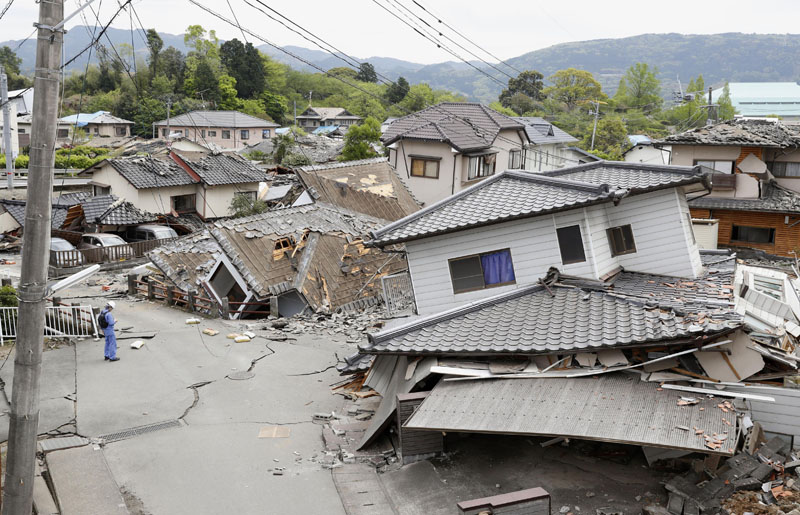Japan quakes kill at least 32; rescuers rush to free trapped
MASHIKI: Army troops and other rescuers rushed Saturday to save scores of trapped residents after a pair of strong earthquakes in southwestern Japan killed at least 32 people, injured about 1,500 and left hundreds of thousands without electricity or water.
Rainfall was forecast to start pounding the area soon, threatening to further complicate the relief operation and set off more mudslides in isolated rural towns, where people were waiting to be rescued from collapsed homes.
Kumamoto prefectural official Riho Tajima said the death toll stood at 22 from the magnitude-7.3 quake that shook the Kumamoto region on the southwestern island of Kyushu early Saturday. On Thursday night, Kyushu was hit by a magnitude-6.5 quake that left 10 dead.
Japanese media reported that nearly 200,000 homes were without electricity, and that drinking water systems had also failed in the area. TV video showed people huddled in blankets, sitting or lying down shoulder-to-shoulder on the floors of evacuation centers. An estimated 400,000 households were without running water.
Chief Cabinet Secretary Yoshihide Suga said that 1,500 people had been injured in the quakes. Tajima said that 184 people were injured seriously, and that more than 91,000 people had been evacuated from their homes. More than 200 homes and other buildings were either destroyed or damaged, she said.
Prime Minister Shinzo Abe expressed concern about secondary disasters as forecasters predicted rain and strong winds later in the day. With the soil already loosened by the quakes, rainfall can set off mudslides.
"Daytime today is the big test" for rescue efforts, Abe said. Landslides have already cut off roads and destroyed bridges, slowing down rescuers.
Police received reports of 97 cases of people trapped or buried under collapsed buildings, while 10 people were caught in landslides in three municipalities in the prefecture, Japan's Kyodo News agency reported.
TV video showed a collapsed student dormitory at Aso city's Tokai University that was originally two floors, but now looked like a single-story building. A witness said he heard a cry for help from the rubble. Two students were reported to have died there.
In the town of Mashiki, where people were trapped beneath the rubble for hours, an unconscious 93-year-old woman, Yumiko Yamauchi, was dragged out from the debris of her home and taken by ambulance to a hospital. Her son-in-law Tatsuhiko Sakata said she had refused to move to shelter with him after the first quake Thursday.
"When I came to see her last night, I was asking her: 'Mother? I'm here! Do you remember me? Do you remember my face?' She replied with a huge smile filled with joy. A kind of smile that I would never forget. And that was the last I saw of her," Sakata said.
Among the other casualties, according to the Kumamoto prefectural government, were a 69-year-old man who died of head injuries and a 28-year-old woman who suffocated.
The area has been rocked by aftershocks, including the strongest with a magnitude of 5.4 Saturday morning. The Japan Meteorological Agency said that the magnitude-7.3 quake early Saturday may have been the main one, with one from Thursday night a precursor.
The quakes' epicenters have been relatively shallow — about 10 kilometers (6 miles) — and close to the surface, resulting in more severe shaking and damage. National broadcaster NHK said as many as eight quakes were being felt an hour in the area.
One massive landslide tore open a mountainside in Kumamoto's Minamiaso village all the way from the top to a highway below. Another gnawed at a highway, collapsing a house that fell down a ravine and smashed at the bottom. In another part of the village, houses were left hanging precariously at the edge of a huge hole cut open in the earth.
Suga, the chief Cabinet secretary, told reporters that the number of troops in the area was being raised to 20,000, while additional police and firefighters were also on the way.
He pleaded with people not to panic. "Please let's help each other and stay calm," he said in a nationally televised news conference.
At a hot springs resort, dozens of people trapped were picked up by military helicopters, Asahi TV reported.
Kyushu island's Mount Aso, the largest active volcano in Japan, erupted for the first time in a month, sending smoke rising about 100 meters (328 feet) into the air, but no damage was reported. It was not immediately clear whether there was a link between the quakes and the eruption. The 1,592-meter (5,223-foot) -high mountain is about a 1 1/2-hour drive from the epicenter.
The historic Aso Shrine, a picturesque complex near the volcano, was seriously damaged, with a number of buildings with curved tiled roofs flattened on the ground like lopsided fans. A towering gate, known as the "cherry blossom gate" because of its grandeur, especially during spring, collapsed.
The Nuclear Regulation Authority reported no abnormalities at Kyushu's Sendai nuclear plant.






